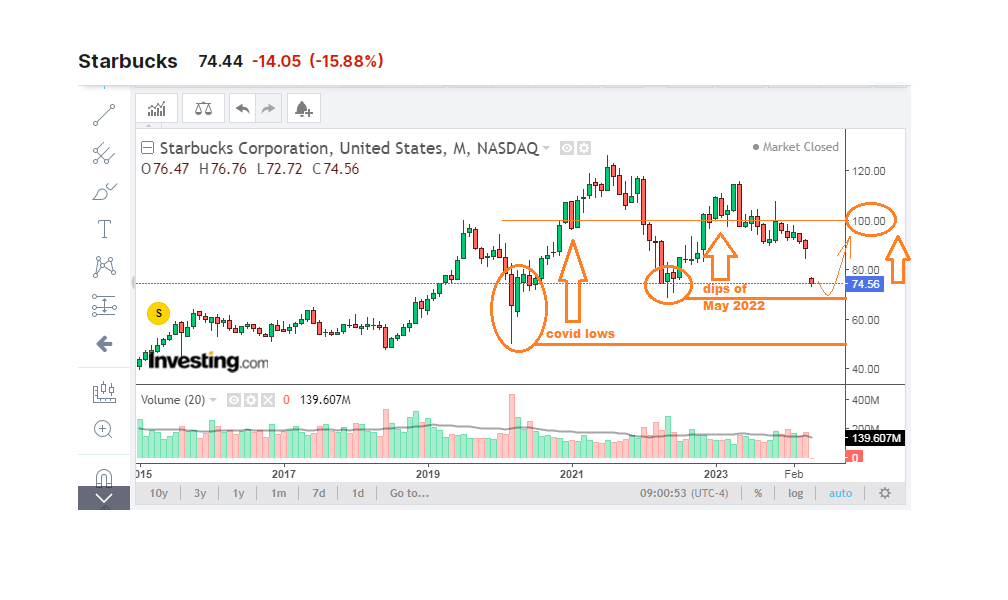I Am Buying More Starbucks Here and Now
At least, I was obviously wrong with my assessment of Starbucks' stocks. The technical path of the coffee house's price went much worse than it could be expected a couple of months ago. Since it performed a fast route from a $90+ area to above $100 per share in early November, I felt as if the best moment to invest passed by. Yet, the stock was treading water near the same price range and even lower for quite a long time after that. Finally, quarterly numbers in after-hours trading on April 30 re-shaped the disposition to temporarily bearish, derailing previous attempts to recover and sending the stock below $75.
A 15.88% drop in one day happened amidst weaker sales and profit numbers during the last quarter, also marked by a decrease in customer visits. Same-store sales were down by 4% YoY globally, and were down by double digits on the Chinese market, citing dampening demand in North America and China, which was the worst thing one could imagine. Equity per share (EPS) amounted to $0.68 only vs consensus of $0.80 (a 15.2% of supposed money inflows was missing). Besides, gross marginality per sold unit was 25.6%, down from 26.2% a year ago, and free cash flow lessened to $629.9 million, down 64.8% from the previous quarter.
The bright side of the bigger picture for me is the growing number of new store locations to reach 38,951 before the end of the quarter, as much as 2,317 higher than 12 months ago. Of course, that was the reason for growing expenses, which did not return quickly, yet are promising to bring more money back even if the business marginality would remain relatively low for a while. I am sure that this globally renowned chain of coffee houses, with a nearly $100 billion of market caps, perfectly knows what it is doing when opening new stores in Asia. It should not be an instant coffee effect, but a far-reaching invigorating contribution to a long history of the company, which successfully taught millions of Americans of drinking proper coffee drinks as they were designed and created in Europe, instead of enjoying a poor excuse for a coffee in fast food points. Now, they are teaching this to their Chinese and broader Asian audience as well. A retreat by value-oriented customers and other forms of consumer weakness, when more families prefer eating at home, as well as unfavourable weather conditions in the US, come and go. Yet the coffee empire remains all penetrating amid competitive pressure.
Not too much time will pass and the current price of $75 per share of Starbucks would be perceived as a blessing, though the price may use this short-lived opportunity to test even lower levels. After all, the price briefly dropped below $70 in May 2022 and reached almost $50 in the covid year of 2020. Many of those who abandoned lost opportunities to buy Starbucks in between $50 and $70, being feared by a fleeting moment, would be biting their elbows later when the price surfaced to above $100 again. Taught by various kinds of experience, I began to add more to my buy positions in Starbucks here and now.

Disclaimer:
The comments, insights, and reviews posted in this section are solely the opinions and perspectives of authors and do not represent the views or endorsements of RHC Investments or its administrators, except if explicitly indicated. RHC Investments provides a platform for users to share their thoughts on financial market news, investing strategies, and related topics. However, we do not guarantee the accuracy, completeness, or reliability of any user-generated content.
Investment Risks and Advice:
Please be aware that all investment decisions involve risks, and the information shared on metadoro.com should not be considered as financial advice. Always conduct thorough research, seek professional advice, and exercise caution when making investment decisions.
Moderation and Monitoring:
While we strive to maintain a respectful and informative environment, we cannot endorse or verify the accuracy of all user-generated content. We reserve the right to moderate, edit, or remove any comments or posts that violate our community guidelines, infringe on intellectual property rights, or contain harmful content.
Content Ownership:
By submitting content to metadoro.com, users grant RHC Investments a non-exclusive, royalty-free license to use, display, and distribute the content. Users are responsible for ensuring they have the necessary rights to share the content they post.
Community Guidelines:
To maintain a positive and respectful community, users are expected to adhere to the community guidelines of Metadoro. Any content that is misleading, offensive, or violates applicable laws and regulations will be subject to moderation or removal.
Changes to Disclaimer:
We reserve the right to update, modify, or amend this disclaimer at any time. Users are encouraged to review this disclaimer periodically to stay informed about any changes.









